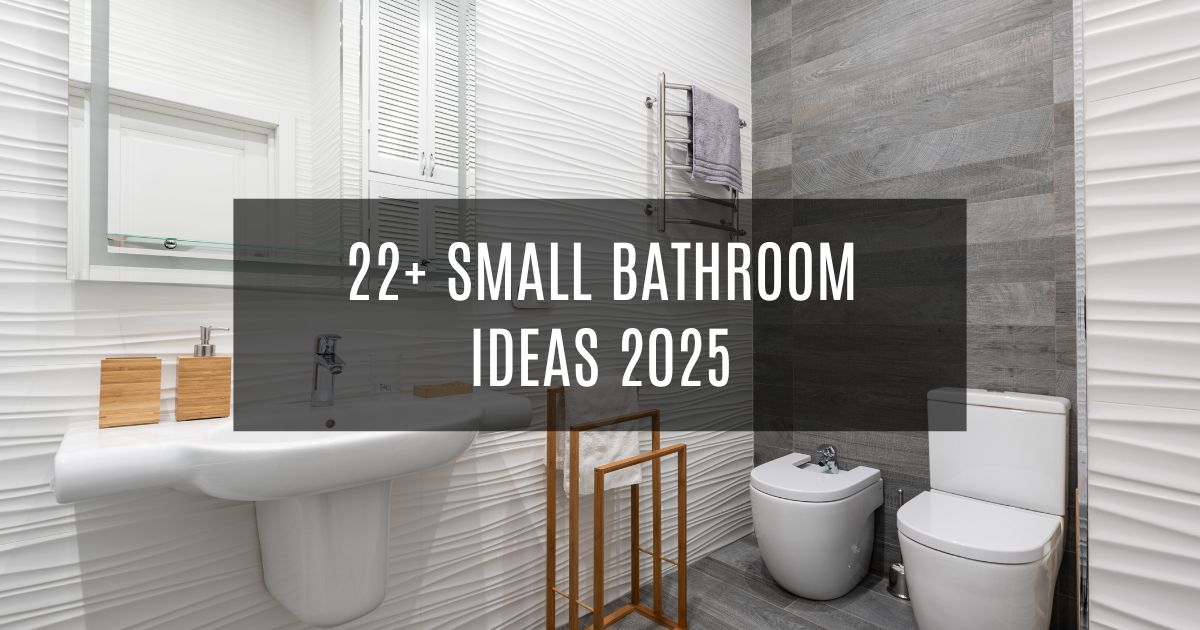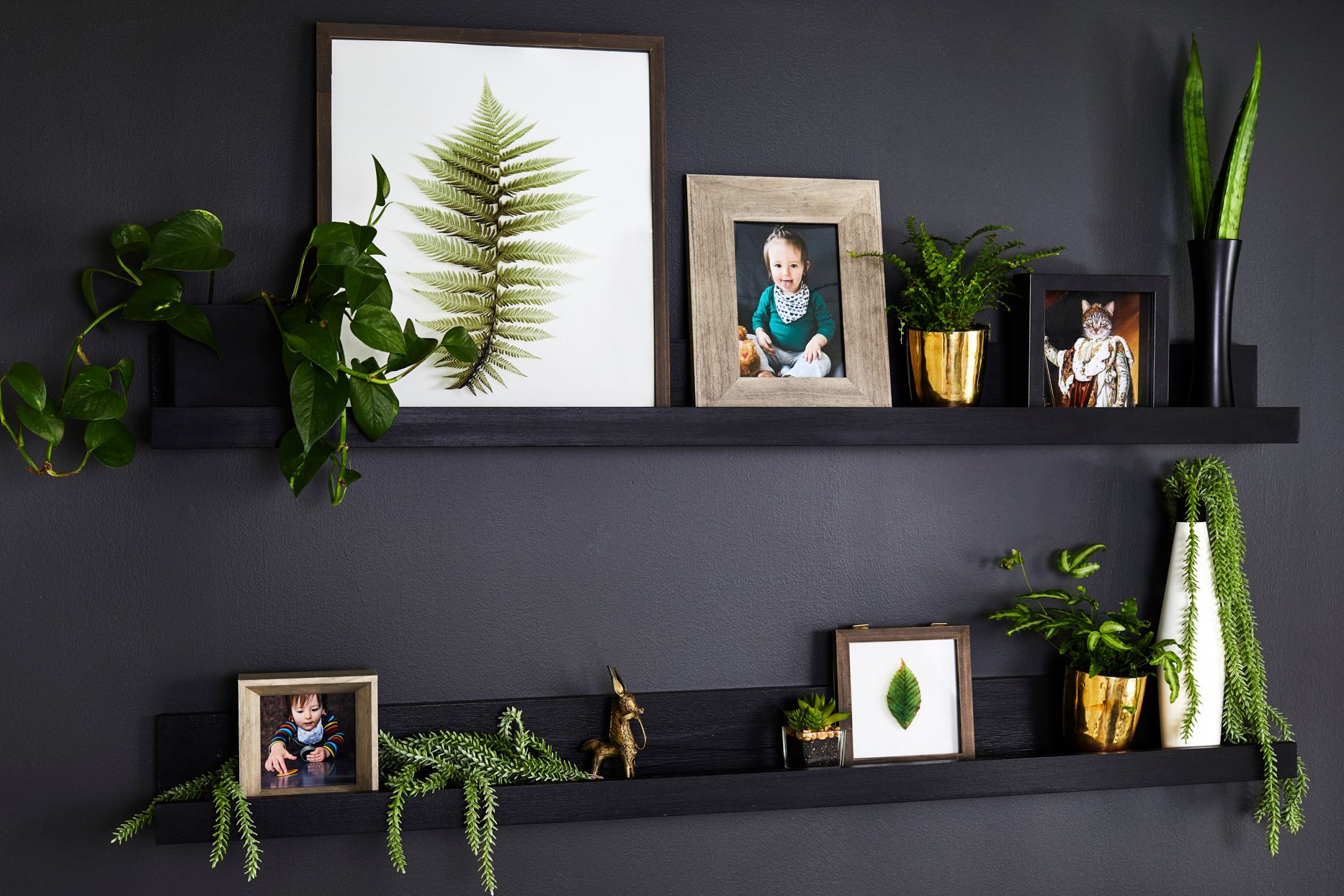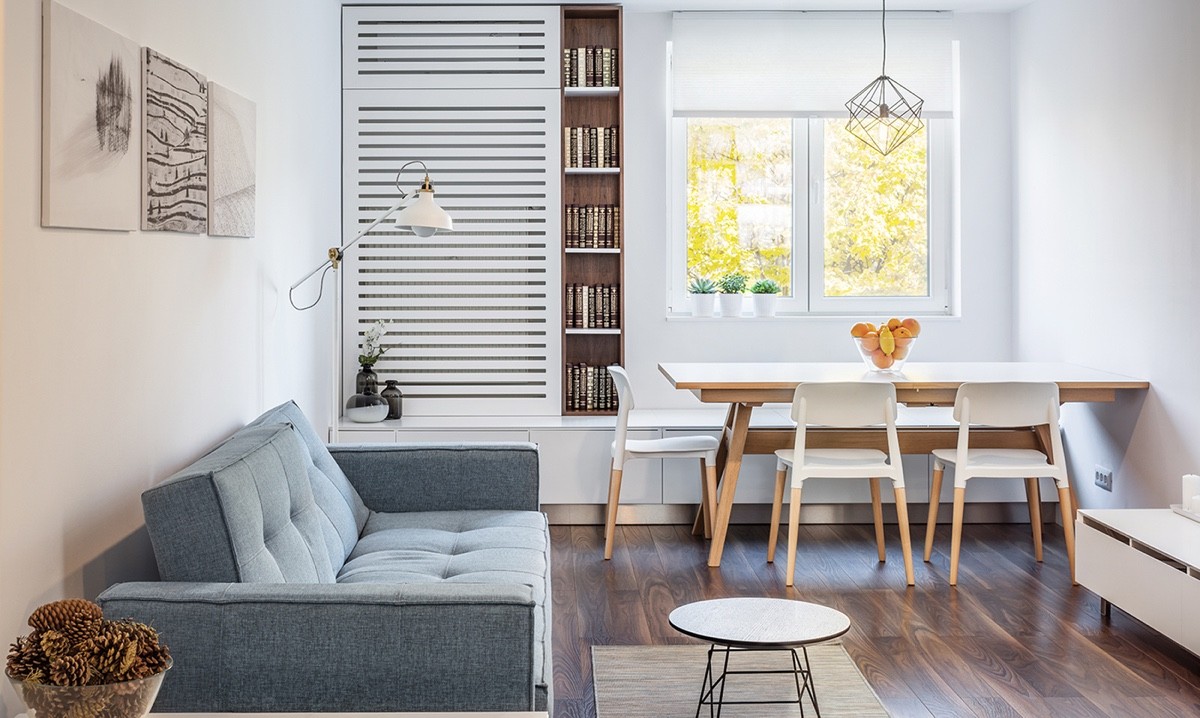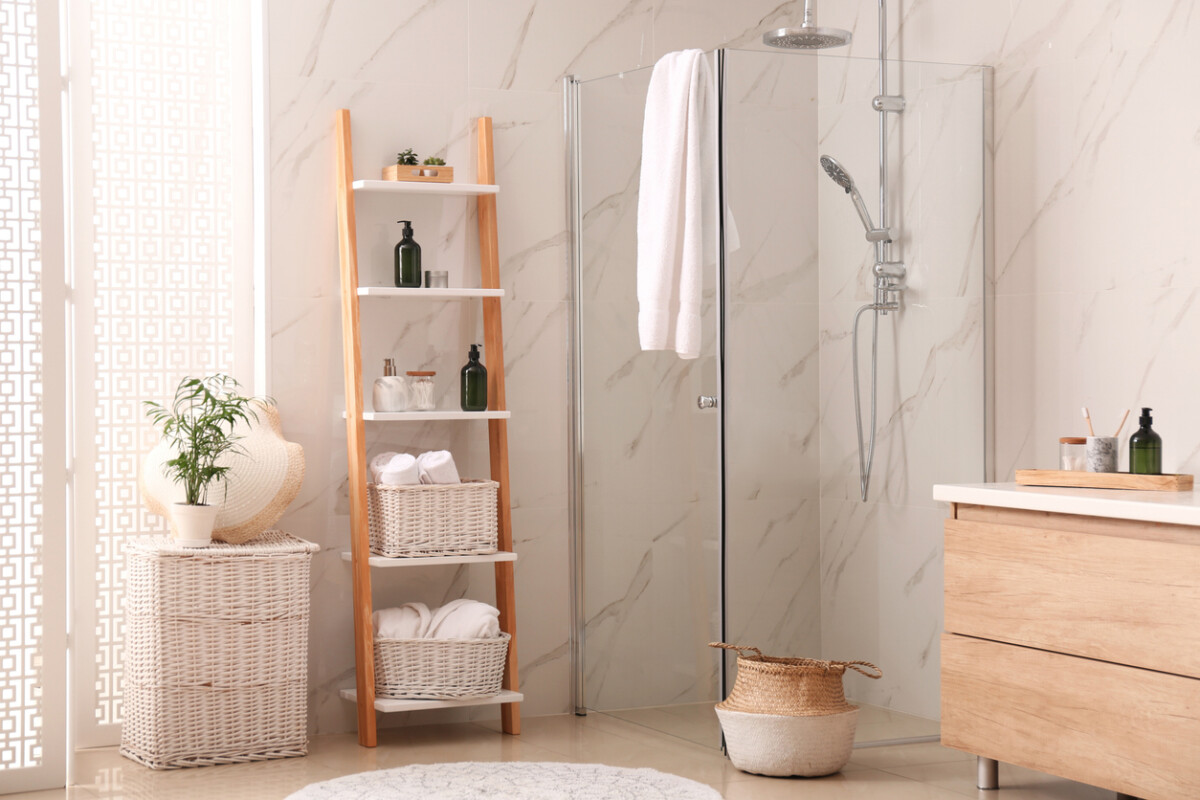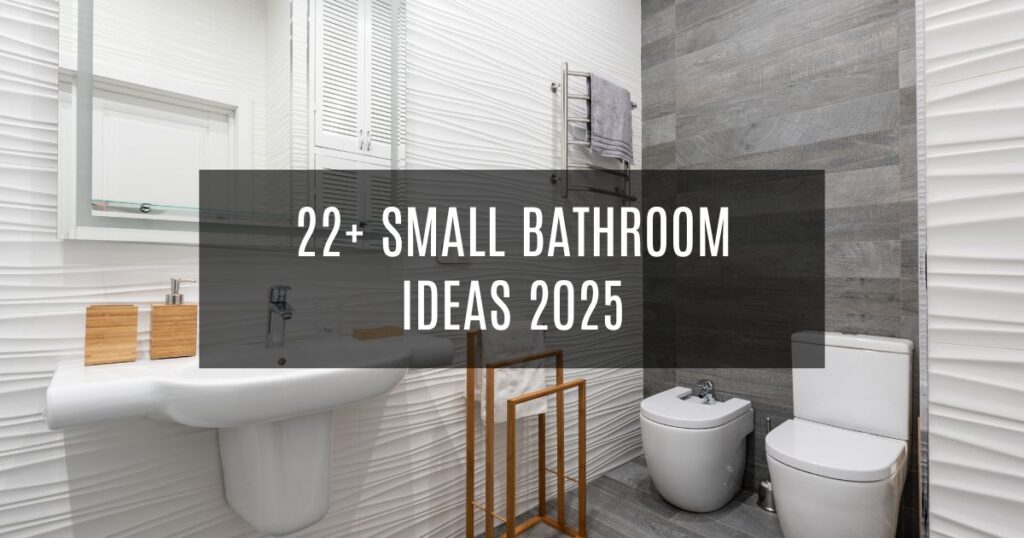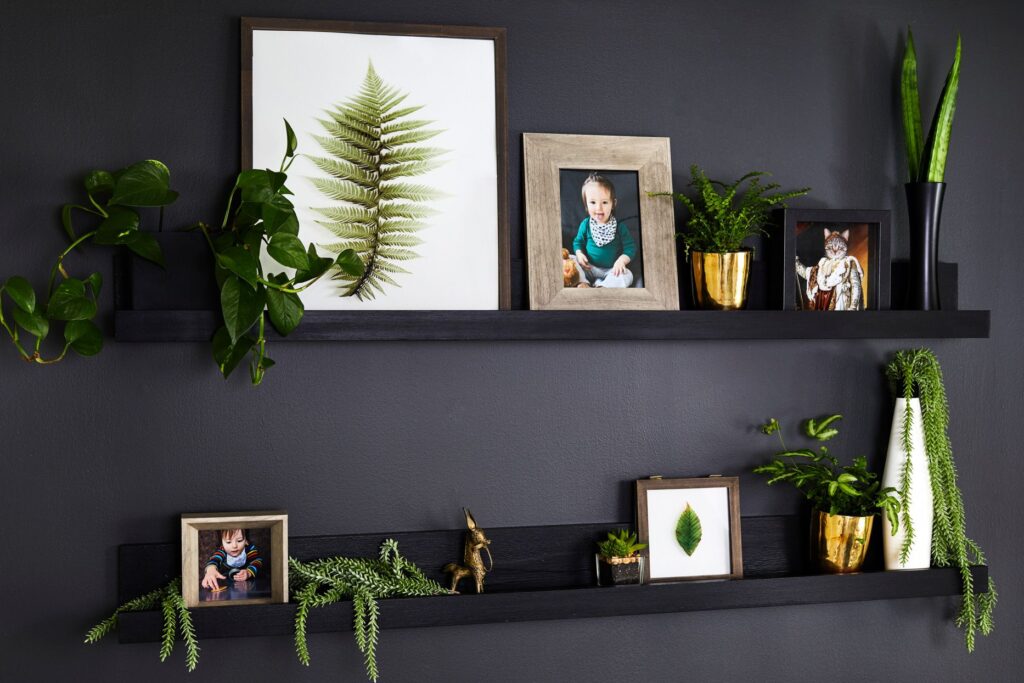Are you ready to transform your outdoor space into a serene sanctuary that reflects both your personality and your practical needs?
If so, incorporating river rocks into your landscaping plans could be the ultimate game-changer.
You might be seeking a low-maintenance way to keep your garden looking pristine, or perhaps you want to add an eye-catching focal point that sparks conversation at your next outdoor gathering.
Whatever your vision may be, river rock landscaping offers an abundance of creative possibilities to elevate the look, feel, and functionality of your yard.
River rocks boast an understated beauty—smooth to the touch, naturally polished, and available in a variety of shapes, sizes, and colors.
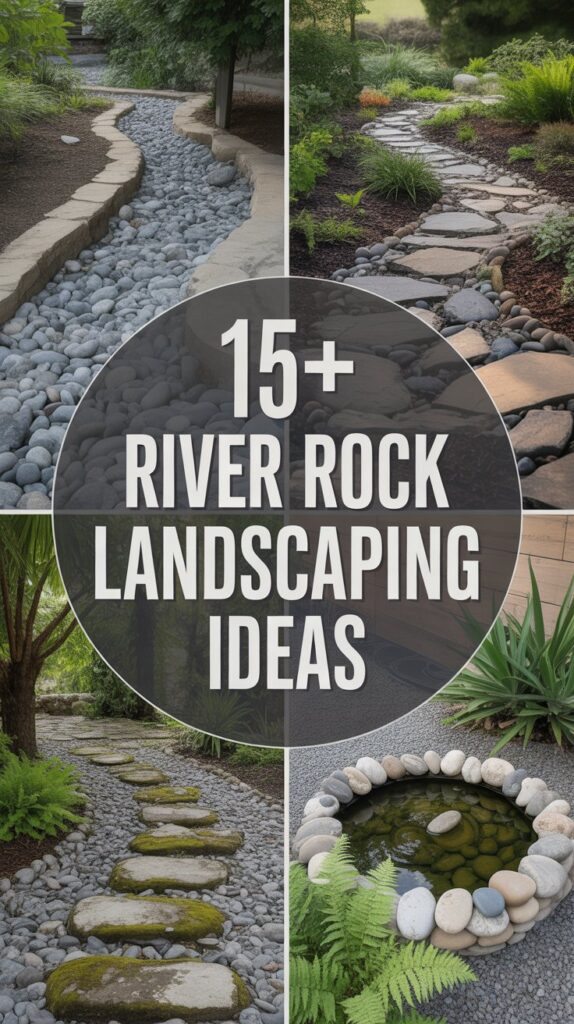
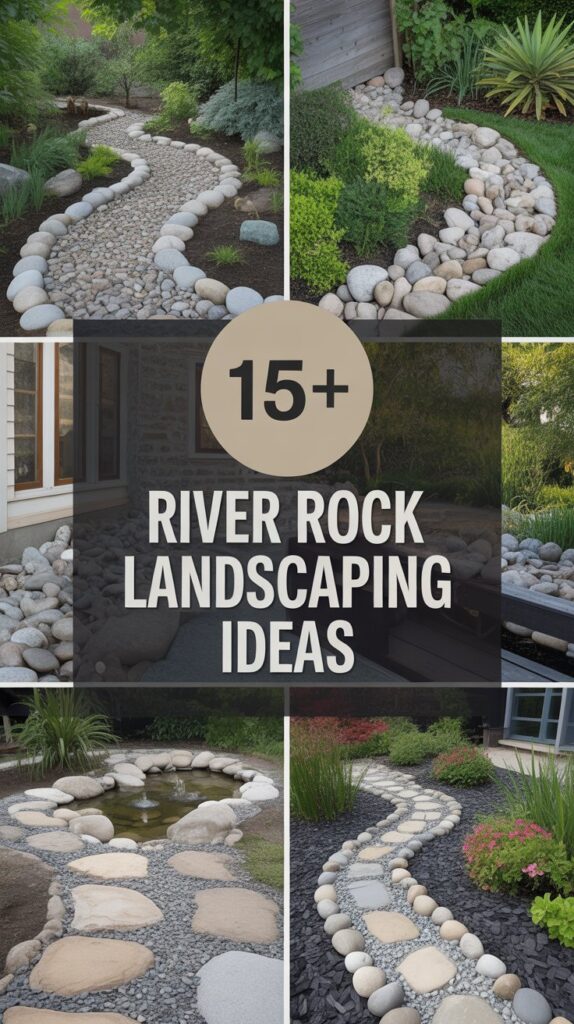
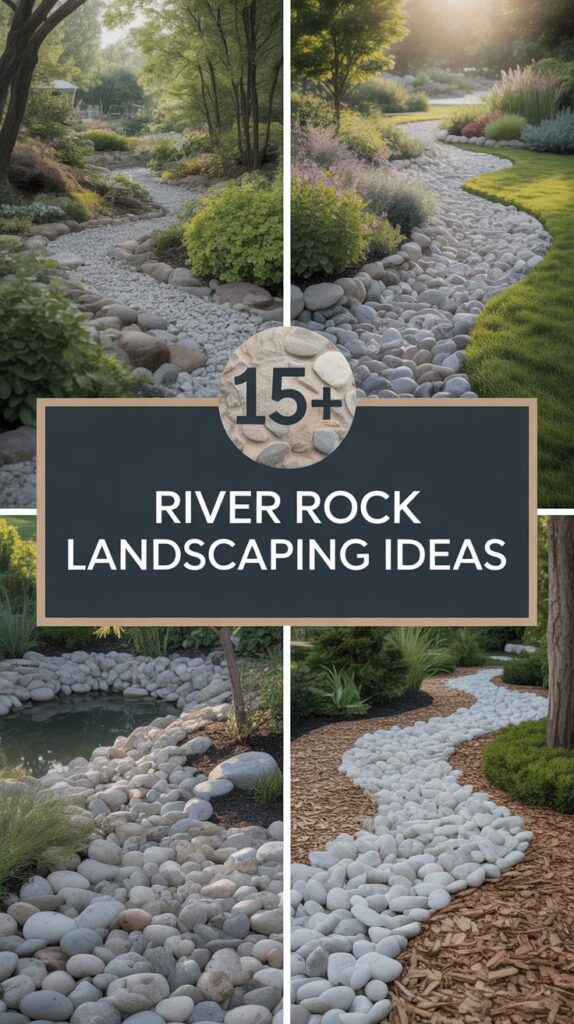
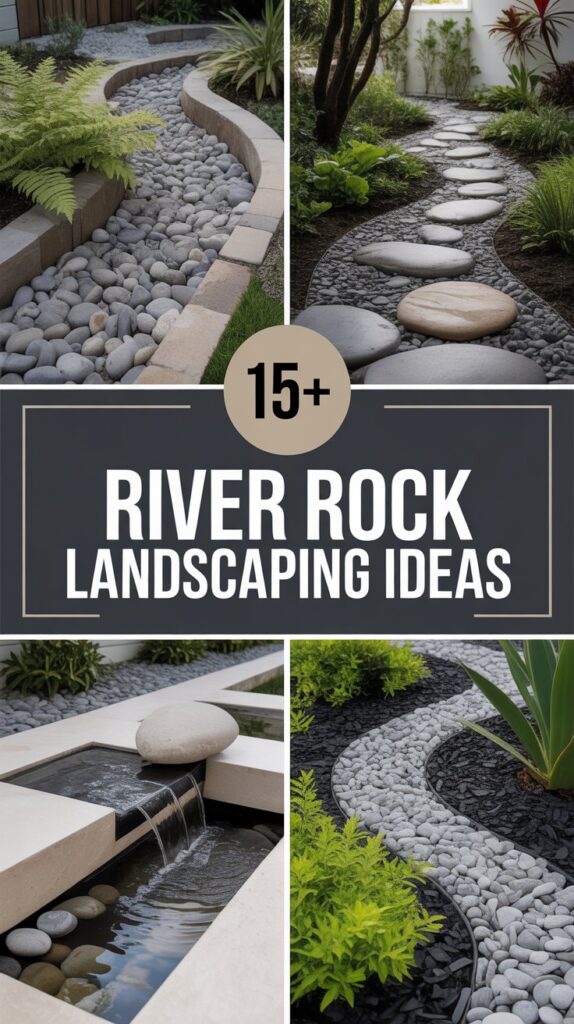
You can arrange them to create winding pathways, stack them for decorative borders, or even use them as an essential part of a water feature.
And the best part?
They are incredibly durable. Once you’ve set up river rocks in your landscape, you can count on them to look great for years to come, requiring minimal upkeep.
If you’re someone who values both style and sustainability, you’ll be pleased to know that river rocks excel in a range of eco-friendly uses.
They can help with drainage, reduce soil erosion, and even serve as rock mulch to minimize water evaporation—particularly helpful if you live in a region prone to droughts.
Plus, their unique textures and natural hues make them a stellar backdrop for planting beds, succulents, or even your favorite perennials.
In this article, you’ll discover over 15 inspiring ways to incorporate river rocks into your landscaping.
From creating mesmerizing water features to designing captivating garden borders, these ideas will help you unleash your creativity and take your outdoor space to the next level.
Read on to explore how river rock landscaping can add both functionality and flair to your yard, bringing you closer to that dream oasis you’ve always envisioned.
Table of Contents
- 15+ River Rock Landscaping Ideas
- 1. Dry Creek Bed
- 2. River Rock Pathway
- 3. River Rock Garden Edging
- 4. Rock Mulch for Flower Beds
- 5. Stream and Waterfall Feature
- 6. River Rock Fire Pit Surround
- 7. Accent Boulders for Focal Points
- 8. Rock Border for Ponds or Water Gardens
- 9. Zen Garden with River Rocks
- 10. River Rock Retaining Walls
- 11. Succulent or Cactus Garden with River Rocks
- 12. River Rock Mosaic or Stepping Stones
- 13. River Rock as Erosion Control
- 14. River Rock Planter Beds
- 15. River Rock Patio or Seating Area
- 16. Rock Landscaping for Xeriscaping
- Conclusion
- Frequently Asked Questions (FAQs)
15+ River Rock Landscaping Ideas
Below, you’ll find a diverse range of ways to incorporate river rocks into your outdoor space. Each idea highlights the unique charm river rocks bring, offering both practicality and aesthetic appeal.
1. Dry Creek Bed
A dry creek bed is one of the most popular ways to feature river rocks in landscaping. The concept is quite simple: you mimic the appearance of a natural stream without constantly running water. By carefully placing river rocks of varying sizes and shapes along a meandering trench, you can create the illusion of a creek winding through your yard.
How to Create It:
- Start by digging a shallow channel where you want your “creek” to flow.
- Line the bottom of the trench with landscape fabric to prevent weed growth.
- Layer river rocks, smaller pebbles, and gravel along the channel, gradually adding larger stones or boulders near the edges to replicate natural stream banks.
- Add decorative elements like driftwood, stepping stones, or even small shrubs along the edges for an authentic look.
Benefits:
- Drainage Improvement: During heavy rainfall, the rocks help direct water away from your home and into safer drainage areas.
- Erosion Control: The bed stabilizes soil on sloped terrains.
- Natural Aesthetic: Dry creek beds blend seamlessly with a variety of garden styles, from rustic to modern.
This landscaping feature offers a serene visual appeal while serving a functional purpose. It’s an excellent choice if you want a focal point that’s both beautiful and low-maintenance.
2. River Rock Pathway
If you’re looking for a charming, durable walkway, a river rock pathway might be the solution you need. Pathways help guide foot traffic, protect lawn areas, and add structure to your landscape layout. With river rocks, you get a surface that’s less likely to crack compared to poured concrete and more adaptable to the natural contours of your yard.
How to Create It:
- Mark the path using stakes and string for straight lines or a garden hose for curved shapes.
- Excavate the area to a depth of a few inches and lay down landscape fabric.
- Add a base layer of crushed gravel for stability.
- Spread river rocks evenly over the pathway, ensuring the surface is level and secure.
Benefits:
- Low Maintenance: River rock pathways require minimal upkeep, needing only occasional raking.
- Versatile: You can use different colors and sizes to complement existing hardscapes or garden features.
- Drainage: Unlike concrete or pavers, water seeps through rocks, preventing puddles and reducing the risk of ice build-up in colder climates.
A river rock pathway not only provides a functional route through your yard but also infuses a soothing, natural atmosphere. It pairs well with rock gardens, water features, or flower beds.
3. River Rock Garden Edging
Tired of unruly garden borders? River rocks can come to the rescue by providing clean, smooth edging for flower beds, walkways, and other garden areas. The subdued, organic tones of river rocks blend seamlessly with vibrant blooms or lush foliage, offering a neat separation between lawns and beds.
How to Create It:
- Dig a shallow trench along the perimeter of the area you want to edge.
- Position larger river rocks in a stable line, forming a boundary wall.
- Fill in any gaps with smaller rocks to create a cohesive look.
- Backfill the trench with soil to hold the rocks in place, and tamp it down to secure the edging.
Benefits:
- Organized Look: Garden edging made of river rocks clearly delineates planting areas from turf or pathways.
- Erosion Prevention: This edging helps keep soil or mulch in place, reducing the chance of runoff after rainfall.
- Customizable: You can vary the height or style by choosing different sizes and arranging them in patterns.
River rock garden edging not only offers practical benefits but also elevates the visual appeal of your landscape. It’s a budget-friendly yet effective way to define spaces with a natural flair.
4. Rock Mulch for Flower Beds
Replacing traditional mulch with river rocks can be a fantastic way to give your flower beds a fresh, modern look. While organic mulches decompose over time, river rocks stay intact and can be reused for years. This saves you the hassle and expense of frequent mulch replacement.
How to Create It:
- Remove existing mulch and clear any weeds or debris from your flower bed.
- Lay down a layer of landscape fabric to block future weed growth.
- Spread river rocks over the fabric, ensuring they’re distributed evenly and at a thickness that covers the fabric completely.
- Trim the fabric at the edges and secure with garden pins, if necessary.
Benefits:
- Durability: Rocks last significantly longer than organic mulch, making them cost-effective over time.
- Heat Retention: They help keep the soil warm, which can be beneficial for certain plant species.
- Weed Control: When paired with landscape fabric, river rocks drastically reduce weed emergence.
However, keep in mind that rock mulch can raise soil temperatures and may not suit all plant types. Choose plants that thrive in warmer, drier conditions, such as succulents or Mediterranean herbs, for best results.
5. Stream and Waterfall Feature
For a more dynamic landscape, consider integrating river rocks into a stream or waterfall feature. Flowing water adds movement and a soothing ambiance to your yard, while river rocks supply the structure and natural appearance necessary for a realistic water setting.
How to Create It:
- Plan the layout for your stream or waterfall—decide how high you want the waterfall to be and where the water will flow.
- Excavate the ground and place an underlayment (like pond liner) to contain the water flow.
- Arrange river rocks in layers, starting with larger stones as the base and smaller stones to fill gaps.
- Install a pump and filtration system to keep the water circulating and clean.
- Add aquatic plants or surrounding greenery to enhance the natural ambiance.
Benefits:
- Relaxing Atmosphere: The sound of flowing water creates a tranquil environment.
- Wildlife Attraction: Birds, butterflies, and other creatures might visit your water feature, enriching your garden ecosystem.
- Year-Round Interest: Even when the pump is off in colder months, the arrangement of river rocks still offers visual appeal.
With the calming sound of cascading water and the organic beauty of river rocks, this feature can become a breathtaking focal point that soothes your senses every time you step outside.
6. River Rock Fire Pit Surround
A fire pit is a social hub in any backyard, perfect for cozy gatherings or simply enjoying the night sky. Incorporating river rocks around your fire pit not only boosts safety by creating a non-flammable surface but also adds rustic charm.
How to Create It:
- Determine the size and location of your fire pit, ensuring it’s a safe distance from structures or vegetation.
- Build or purchase the fire pit ring or bowl.
- Clear the surrounding area and lay down landscape fabric or a gravel base.
- Place river rocks around the perimeter of the fire pit, extending out a few feet to catch stray embers.
- Consider adding seating, such as wooden benches or Adirondack chairs, to complete the cozy setting.
Benefits:
- Safety: The stones form a protective barrier against fire spreading.
- Aesthetic Harmony: River rocks blend well with both modern and rustic fire pit designs.
- Low Maintenance: River rocks are durable and weather-resistant, requiring minimal upkeep.
Whether you’re roasting marshmallows or chatting with friends, a fire pit surrounded by river rocks offers both function and flair, establishing a warm gathering place in your backyard.
7. Accent Boulders for Focal Points
Sometimes, a single large boulder can transform the entire feel of your garden. Accent boulders work as eye-catching focal points, drawing attention to specific areas and adding a sense of grandeur. River rocks aren’t limited to small pebbles—many landscaping suppliers also carry large, smooth stones or boulders with similar characteristics.
How to Use Them:
- Identify a spot where you want a dramatic element—near a pond, at a curve in a pathway, or beside a seating area.
- Prepare the ground by leveling or slightly excavating the area.
- Place the boulder (using professional help if it’s very large) so it appears naturally anchored.
- Add smaller river rocks around the base to blend it smoothly into your existing landscape.
Benefits:
- Visual Impact: A carefully placed boulder can serve as a striking centerpiece or a quiet accent.
- Versatility: Whether your garden style is Asian-inspired, modern, or cottage-like, a natural stone focal point can fit right in.
- Durability: Boulders are virtually maintenance-free and last a lifetime.
Pair accent boulders with ornamental grasses, low-growing groundcovers, or water features to elevate their effect and enhance the overall visual harmony.
8. Rock Border for Ponds or Water Gardens
Ponds and water gardens are natural magnets for the eye, offering serenity and a home for aquatic plants and fish. River rocks can be used to create beautiful, stable borders around these water features, preventing soil erosion and adding a polished rim.
How to Create It:
- After digging and lining your pond, secure the liner around the edges.
- Arrange medium to large river rocks along the pond’s perimeter to hide the liner and hold it in place.
- Fill gaps with smaller pebbles or gravel.
- For a more lush look, plant aquatic greenery at the water’s edge or add mossy rocks in shady spots.
Benefits:
- Erosion Control: Rocks lock the pond edges in place, preventing soil from slipping into the water.
- Blended Look: River rocks hide the synthetic liner, creating a more organic appearance.
- Safe Habitat: The stones offer stable surfaces for frogs, birds, and other wildlife to perch.
This approach seamlessly integrates your pond or water garden into the broader landscape, making it feel like a naturally occurring oasis.
9. Zen Garden with River Rocks
A Zen garden (also known as a Japanese rock garden) is all about minimalism, balance, and tranquility. River rocks, with their smooth surfaces and gentle colors, are perfect for creating the peaceful ambiance central to Zen-inspired spaces.
How to Create It:
- Choose a quiet corner of your yard where you can achieve a sense of seclusion.
- Clear the area of plants and debris, then level the soil.
- Lay down a layer of sand or fine gravel and rake it into smooth patterns.
- Place river rocks in carefully curated groupings, leaving space for small shrubs or decorative stones.
- Consider adding a bench or small water basin for a complete Zen experience.
Benefits:
- Meditative Atmosphere: The simple act of raking patterns in the sand can be calming.
- Low Maintenance: Zen gardens typically feature few plants, so upkeep is minimal.
- Timeless Style: The crisp simplicity of a Zen garden complements both traditional and modern landscapes.
Incorporating larger boulders or stone lanterns will amplify the meditative vibe, making your Zen garden a tranquil retreat for daily reflection.
10. River Rock Retaining Walls
If your property has varying elevations or slopes, retaining walls can prevent soil erosion and create tiered garden spaces. River rocks can be used in conjunction with other materials—like gabion baskets or mortar—to form sturdy, visually appealing walls.
How to Create It:
- Assess the slope and design the retaining wall height and length.
- Install a stable foundation layer; if using gabion baskets, place them according to manufacturer guidelines.
- Fill the baskets or build the wall with medium to large river rocks, ensuring they’re tightly packed.
- Add drainage behind the wall to prevent water buildup and ensure long-term stability.
Benefits:
- Soil Stabilization: Prevents erosion in sloped areas.
- Visual Texture: The smooth contours of river rocks contrast beautifully with plants and other hardscape features.
- Long-Lasting: Well-constructed retaining walls can last for decades with minimal maintenance.
With the addition of ornamental plants or creeping groundcovers in the tiers, a river rock retaining wall can turn an otherwise challenging slope into a functional and attractive garden highlight.
11. Succulent or Cactus Garden with River Rocks
Succulents and cacti thrive in well-draining soil and sunny conditions. River rocks offer an excellent top-dressing to help the soil dry out, reducing the risk of root rot. The pale or earthy tones of the rocks also complement the unique shapes and colors of succulents.
How to Create It:
- Amend your soil with sand or a well-draining mix designed for succulents and cacti.
- Arrange your succulents and cacti according to their light and spacing requirements.
- Surround the base of each plant with a layer of river rocks, ensuring the soil isn’t compacted.
- Water sparingly, following the specific needs of your chosen plants.
Benefits:
- Water Efficiency: Ideal for drought-prone regions and those seeking low-water landscapes.
- Striking Contrast: The smooth texture of the river rocks highlights the architectural form of succulents and cacti.
- Weed Suppression: A layer of rocks discourages weed growth, keeping your garden tidy.
This setup appeals to gardeners who love modern, minimalist aesthetics and desire an easy-care garden that stays vibrant year-round.
12. River Rock Mosaic or Stepping Stones
Turn your landscaping into a one-of-a-kind masterpiece by creating mosaics or stepping stones with river rocks. This adds a custom artistic element to your yard, allowing you to express creativity while providing a functional pathway or focal point.
How to Create It:
- Decide on a pattern or motif—flowers, geometric shapes, or abstract designs.
- Use molds for stepping stones or mark the area for an in-ground mosaic.
- Mix mortar or concrete according to instructions and pour a layer into the mold or excavated area.
- Press river rocks into the wet mix, arranging them in your chosen design.
- Let the surface cure before adding any protective sealant.
Benefits:
- Artistic Flair: A mosaic can transform a plain path into an artistic centerpiece.
- Customizable: Incorporate colored glass or ceramic tiles alongside river rocks for a more eclectic look.
- Personal Touch: Children and family members can help place the rocks, adding sentimental value.
A river rock mosaic or stepping stone collection can be a fantastic conversation starter, showcasing your garden’s personal touch and creative spirit.
13. River Rock as Erosion Control
Sloping gardens or areas with heavy runoff can be challenging to maintain. River rocks come in handy for erosion control, as their weight and arrangement help stabilize soil, especially during heavy rains. Whether you prefer large, strategically placed boulders or a blanket of smaller river stones, they can effectively curb soil displacement.
How to Implement It:
- Identify the slope or area of erosion concern.
- Prepare the ground by removing debris and leveling where necessary.
- Lay landscape fabric or geotextile material to help reinforce the soil.
- Place river rocks systematically, starting from the bottom of the slope upward, ensuring each layer is stable.
- Incorporate terraced steps or retaining walls for severe slopes.
Benefits:
- Protection: Minimizes soil loss and potential damage to plants or structures.
- Water Management: Rocks can slow water flow, allowing it to absorb into the soil gradually.
- Aesthetic Bonus: Instead of unsightly erosion trenches, you get an attractive rock-covered slope.
River rocks offer both form and function when it comes to stabilizing tricky terrains, making them invaluable for hilly landscapes or regions prone to heavy rainfall.
14. River Rock Planter Beds
Elevate your container gardening game by crafting raised planter beds accented or constructed with river rocks. You can build raised walls using gabion baskets filled with river rocks or simply place a ring of large stones to hold soil for a raised bed.
How to Build It:
- Choose a sunny spot with good drainage.
- Lay out the shape of the planter bed—circular, rectangular, or free-form.
- If using gabion baskets, assemble them and fill with river rocks as per the instructions. Otherwise, stack large stones to form a perimeter.
- Fill the enclosed space with high-quality garden soil.
- Plant flowers, vegetables, or herbs that suit your climate and sunlight conditions.
Benefits:
- Improved Drainage: The rock walls allow air to flow and water to drain effectively.
- Thermal Retention: Rocks can help maintain consistent soil temperatures.
- Eye-Catching Design: The contrast between lush plants and smooth river rocks is visually striking.
With proper planning, river rock planter beds can be as practical as they are beautiful, giving you a show-stopping feature for growing vegetables, herbs, or ornamental plants.
15. River Rock Patio or Seating Area
Create a cozy seating area or patio using a layer of river rocks as the foundation or surface. This approach can be more cost-effective than pavers or concrete, while still offering a stylish, laid-back vibe. Plus, it drains well, so puddles won’t ruin your get-togethers after a drizzle.
How to Create It:
- Choose a flat section of your yard that’s large enough for chairs, a table, or a fire pit.
- Excavate a few inches of soil and level the ground.
- Lay landscape fabric to suppress weeds.
- Spread crushed gravel as a base, followed by a top layer of river rocks.
- Add outdoor furniture, potted plants, or decorative elements like lanterns or string lights.
Benefits:
- Budget-Friendly: Typically cheaper than installing a concrete or stone patio.
- Quick Drainage: You won’t have to worry about pooling water.
- Comfortable Aesthetic: The natural texture complements both modern and rustic outdoor furniture styles.
While you can certainly walk on river rocks, consider adding pavers or stepping stones for high-traffic areas to ensure stability, especially if you plan to place tables or heavier furniture.
16. Rock Landscaping for Xeriscaping
Xeriscaping is a landscaping method designed for minimal water use, often popular in arid regions. River rocks can play a pivotal role in such designs by replacing large swaths of turf grass and serving as a decorative, low-maintenance groundcover.
How to Implement It:
- Remove existing lawn or invasive plants, ensuring the soil is well-draining.
- Position drought-tolerant species like succulents, ornamental grasses, or native plants.
- Cover remaining open areas with river rocks, leaving room around plant bases for root growth and water absorption.
- Incorporate strategic hardscapes such as gravel walkways, stepping stones, or boulder accents.
Benefits:
- Reduced Water Usage: Ideal for regions with watering restrictions or drought conditions.
- Lower Maintenance: No frequent mowing, fertilizing, or reseeding like you’d need with turf grass.
- Visual Diversity: Contrasting the greenery of drought-tolerant plants with the subtle colors of river rocks creates a stunning visual tapestry.
By adopting xeriscaping principles, you can create a sustainable, water-wise garden that’s as appealing as it is eco-conscious.
Conclusion
River rock landscaping opens up a world of possibilities for blending functionality and visual appeal in your outdoor space. From the subtle elegance of garden edging to the dramatic impact of large accent boulders, these smooth, durable stones can transform ordinary yards into personalized retreats. They excel in problem-solving tasks such as drainage and erosion control, all while maintaining a natural aesthetic that complements a wide variety of design styles.
Whether you’re seeking a low-maintenance solution or aiming to introduce a fresh, artistic touch, river rocks offer the flexibility and longevity you need. As you explore the ideas above—like dry creek beds, rock mulch in flower beds, or a soothing water feature—keep your unique style and local climate in mind. By choosing the right combination of plants, hardscapes, and river rock elements, you’ll craft a landscape that stands the test of time, both in beauty and practicality.
Think of this guide as your starting point for inspiration. There are countless ways to adapt these ideas, mix and match elements, and create an outdoor haven you’ll love for years. Ultimately, your landscaping journey with river rocks can be as simple or elaborate as you desire. So go ahead, embrace your creative instincts and transform your yard into the natural oasis of your dreams.
Frequently Asked Questions (FAQs)
Q1: Can I use river rocks in a small yard or balcony garden?
Absolutely. While large-scale projects like dry creek beds might require more space, you can still incorporate river rocks in smaller contexts—such as container gardens, potted succulents, or tiny Zen gardens—to add texture and contrast.
Q2: Do river rocks get too hot for plants in direct sunlight?
River rocks can retain heat, which might raise the temperature of the surrounding soil. If you live in a hot climate, choose heat-tolerant or drought-resistant plants when pairing them with river rocks. You might also opt for lighter-colored stones that reflect, rather than absorb, sunlight.
Q3: How do I keep river rocks clean and free of debris?
Over time, leaves and dirt can accumulate among the rocks. You can use a leaf blower or a gentle spray from a garden hose to clear debris. For more stubborn buildup, try a mild cleaning solution and a soft-bristle brush.
Q4: Are river rocks expensive compared to other landscaping materials?
Costs vary depending on your location and the quantity you need. Generally, river rocks can be pricier than basic gravel but still competitive compared to high-end pavers or stone slabs. Purchasing in bulk and working with a local supplier can help reduce costs.
Q5: Can I place river rocks directly on the ground without any base layer or fabric?
You can, but adding landscape fabric or a gravel base is recommended for weed control and proper drainage. Placing rocks directly on soil increases the chance of weeds sprouting through and can lead to uneven sinking over time.
Q6: Is it okay to mix different sizes and colors of river rocks in one project?
Absolutely. Mixing sizes and colors can add visual depth and interest. Just ensure the combination aligns with your landscape’s overall design. You might keep the color palette consistent and vary only the sizes, or vice versa.
Q7: What are some low-maintenance plants that pair well with river rocks?
Succulents, cacti, ornamental grasses, lavender, and many native drought-tolerant species pair wonderfully with river rocks. These plants require less frequent watering and thrive in well-draining soil conditions.

